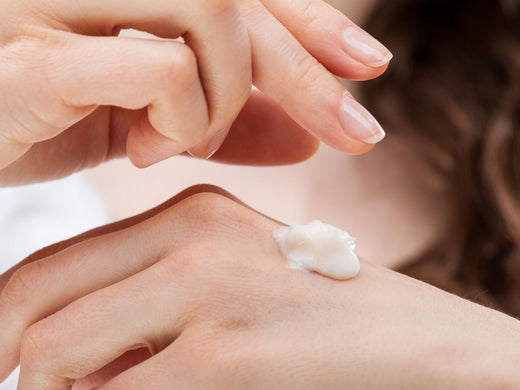

According to current studies, more than eight million Americans (and 125 million people worldwide) have psoriasis. And yet, despite its prevalence, it’s a skin condition that’s largely still misunderstood—not to mention misidentified given its similarities to eczema, a much more common skin condition that affects 31.6 million people in the U.S..
Due to the frequent mix-up, we figured a guide to all things psoriasis and eczema could be of great use. While only a dermatologist can properly diagnose psoriasis and eczema (and determine the best course of treatment), this article will serve as an introductory course to the topic so that if you notice any irritation, you’ll have a better sense of how to move forward. Ahead, everything you need to know about eczema vs psoriasis before you visit your dermatologist.
What Is Psoriasis?
Have you ever experienced extreme itching associated with inflammation? If so, psoriasis could be to blame.
Psoriasis is a chronic, immune-mediated disease that causes raised, red, scaly patches to appear on the skin. While the exact cause of psoriasis is unknown, it’s thought to be due to alterations in the immune system which lead to inflammation and increased turnover of cells. Normally, skin cells are replaced every 10 to 30 days. In people with psoriasis, new cells grow every three to four days. This proliferation of cells causes a buildup of old cells, with new cells piling on top, which causes the look of bumpy red patches covered in thick, white, or silvery patches.
These are very characteristic of psoriasis. They can grow anywhere, but most appear on the scalp, elbows, knees, and lower back. While this might look extreme, psoriasis is not contagious or infectious.
Typical Onset for Psoriasis
While psoriasis can occur at any age, the average age of onset can occur at two different peaks, either 15-35 years or at 55-60 years old, yet noting that, while rare, about 10 to 15 percent of psoriasis cases occur before the age of 10.
What’s more, psoriasis tends to run in families, though, exactly what’s passed down is not clear.
Additionally, unlike some skin conditions, men and women develop psoriasis at similar rates, and it’s seen across all racial groups. Caucasians develop psoriasis at a rate of about 3.6 percent compared with African-Americans who develop psoriasis at a rate of 1.9 percent.
What Is Eczema?
Then there’s eczema. While eczema can be equally as itchy and inflamed, it doesn’t include the scaley patches that psoriasis does. Eczema describes a condition when the skin becomes red, itchy, dry and sometimes flaky, which can affect any part of the body.
It’s generally due to inflammation of the skin, but some triggers include dryness of the skin, stress, or if the skin comes into contact with something that can be irritating such as harsh soaps, detergents, chemicals, or clothing with a rough texture (such as wool clothing). For some people, intense heat and humidity can aggravate the skin as well.
There is more than one type of eczema, though. Atopic dermatitis is considered a chronic form of eczema which can run in families. Atopic dermatitis is a condition that makes your skin red and itchy—and sometimes scaly (though not as much so as psoriasis). It's common in children but can occur at any age. While eczema can go away over time, atopic dermatitis is chronic and tends to flare periodically. What’s more, it may be accompanied by asthma or hay fever.
Typical Onset for Eczema
Eczema flares can start as early as one to six months after birth. According to Mayo Clinic, atopic dermatitis—the more extreme type of eczema—typically starts before the age of five and can continue into adolescence and adulthood.
For some people, it flares periodically and then clears up for a time, even for several years, noting that the flares can feature thin red plaques covered in dry scales, and most often occur in flexor areas of the body, like the insides of the elbows and the backs of the knees. While the cause is still unknown, a genetic predisposition is largely to blame.
Eczema vs. Psoriasis: Key Differences
Now that you know that both eczema and psoriasis can be itchy and inflamed, you might be scratching your head wondering what exactly sets them apart then. To help break it down, we’ve listed out the key differences, below.
Timing. Where psoriasis usually appears in early adulthood, eczema can start as early as a month after birth.
Causes. Eczema can be caused by inherited changes of the skin or a reaction to a skin allergen, and is often associated with allergies and eczema. Psoriasis is a result of irregular immune system signaling, and it can be associated with psoriatic arthritis, a disease that affects joints.
Appearance. While atopic dermatitis can be associated with thin scales, standard forms of eczema are simply red and bumpy. Psoriasis, on the other hand, features raised bumps and scales, which have been said to lead to far more than just a cosmetic problem.
Location. Psoriasis can occur anywhere—even on the hands, feet, genitals, and nails. Eczema, however, typically occurs within the folds of elbows and knees, and occasionally on the face, eyelids, and creases of the groin.
Feel. While psoriasis can be itchy, it’s mainly just raised and inflamed. While eczema can be raised and inflamed, it’s often drier and more itchy than anything else.
Cures. While no true cures have been found for eczema or psoriasis, the fact of the matter is that, in some cases, eczema can disappear. Psoriasis, however, is a life-long condition that requires being managed. And, in some cases, such management can lead to remission.
Side Effects. In recent years, skin care experts have learned that psoriasis is associated with other serious health conditions, such as diabetes, cardiovascular disease, and depression. Alternatively, eczema isn’t associated with any serious health conditions—it’s largely cosmetic.
Identifying Eczema vs. Psoriasis on the Face
When psoriasis affects the face it often appears on the hairline, in or behind the ear, or on the scalp. Though, it can also occur on the eyebrows and the skin surrounding the nose. The patches or plaques are often well defined with sharp borders. On the face, psoriasis sometimes occurs in association with seborrheic dermatitis, a common skin condition that can also cause red or pink scaly patches.
Conversely, eczema on the face is more common on the eyelid skin or around the mouth, often as a result of a contact dermatitis. Prolonged eczema around the eyes can make the skin look wrinkled and discolored, a phenomenon sometimes referred to as 'allergic shiners.'
Given the similarities, it can be especially challenging to distinguish between eczema and psoriasis on the face. That said, the biggest hints are that eczema favors the area or around the eyes and mouth, while psoriasis favors the forehead, extending from the brows to the hairline, sometimes covering everything in between.
Identifying Eczema vs. Psoriasis on the Body
Remember: Eczema typically falls within join folds, while psoriasis congregates just about anywhere, though most commonly on the knees, elbows, and scalp. However, if you have inverse psoriasis (a form exacerbated by friction and sweating), you may also find psoriasis scales in groin folds, under the arms, and below the breasts. Additionally, if you notice little dents in your nails, that could also be a sign of psoriasis.
Beyond location, eczema is much less defined than psoriasis. So, if you notice dry patches without redness or a raised silhouette, eczema is most likely more to blame. However, remember that only a doctor can officially deem it so.
The most definitive way to distinguish the two is with a skin biopsy, although there are scenarios when even that is not conclusive to differentiate the two,.
Treating Eczema
Remember, only a dermatologist can prescribe a course of treatment (and a proper diagnosis). But here's roughly what you can expect:
Before you can treat eczema, you have to understand the underlying cause. To treat eczema, it’s important to elucidate the underlying cause. If it is from a skin allergy, one must eliminate exposure to it. If it’s from dry skin, one must modify the way they are treating their skin.
It’s because of this that education is key.
Though it’s not curable, it is manageable. Moisturizing the skin is a mainstay of treatment for eczema. When the skin is dry and cracked, the normal barrier function of the skin is compromised. This will lead to inflammation and redness. To avoid this, moisturize your skin with a fragrance-free, ceramide-rich lotion, ointment, or cream at least twice a day. What’s more, it’s important to cut out anything that exacerbates the irritation—like long, hot baths or showers, which can further strip the skin of moisture. If simple OTC creams aren’t working, consider prescription treatment, such as nonsteroidal anti-inflammatory creams.
Now, if your eczema extends beyond itching and redness you can address plaques with topical steroids. They should be used sparingly and under the guidance of a physician. Sometimes if the lesions of eczema get infected by bacteria, antibiotics are also used.
Treating Psoriasis
Once again, only your dermatologist can properly diagnose and treat psoriasis. But here's what most individuals can expect:
As much as we wish an OTC ointment could work wonders for psoriasis, at the end of the day your best is to consult a board-certified dermatologist to find out how to best navigate the skin disease, and take a natural approach to your skin care.
Considering this is no true treatment for psoriasis, any treatment strives to manage a person’s symptoms, not cure it. Therefore, treatment varies from person to person. Psoriasis treatments include steroid creams, light therapy and immune system modulating medications such as biologics. Keratolytic products (products that break up the thick plaques of dead skin cells) such as retinoids, salicylic acid, urea creams are also sometimes used.
When in doubt, an easy to use daily body cream is the Eczema & Psoriasis Cream from Wild Naturals. Shop the online store for every product you want tailored to these two skin conditions!


